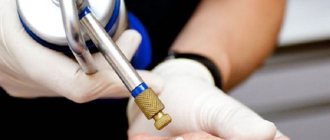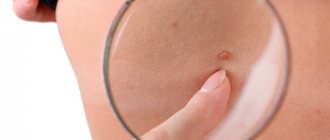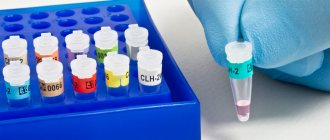Moles are one of the most common reasons for patients to seek treatment. However, this is not a medical diagnosis, but a collective group of various skin tumors. Among moles, many benign skin tumors can be distinguished: nevi of various types (melanocytic and non-malanocytic), seborrheic keratosis, dermatofibromas, soft and hard fibromas. Also among moles there are malignant tumors: melanoma, basal cell carcinoma, skin cancer. Only a part of these moles can be easily removed with liquid nitrogen; the other part is very resistant to such effects.
Moles and papillomas
Moles are commonly called pigmented formations on the skin. Doctors gave them another name - nevi. They are formed from pigment cells. In fact, a mole is a benign tumor. Most often it is located between the epidermis and dermis. Sometimes one or more moles can be found on the mucous membranes. For example, in the mouth or vagina. Nevi can be of different colors: brown, purple, black, blue, red and others. Sometimes moles are colorless. The reasons for their formation are as follows: Some papillomas, in appearance, are similar to colorless moles. Sometimes they grow and resemble cauliflower. These tumors most often form on the face, neck and chest. The cause of such growths is the human papillomavirus. Infection occurs as follows:
- Sexually.
- Autoinfection. For example: during hair removal or shaving.
- Infection of the baby during childbirth.
- By everyday means. The virus enters the body through microscopic abrasions or cuts in the skin.
In most cases, the reason for removing moles and papillomas is aesthetics, not health. The patient simply does not like the appearance of the growth or it is too noticeable to others. In some cases, neoplasms are traumatized by clothing or a chain around the neck. This forces the patient to see a doctor to get rid of the growth.
Traditional methods of tumor removal: painful, dangerous and ugly
Surgical
– the doctor, under local anesthesia, excises the formation and sutures the skin. The procedure takes 30 minutes or more. After the stitches are removed, scars and even serious scars remain, which are not always “erased” by skin polishing.
The surgical method of removing tumors is positioned as simple and cheap. But, if you consider the amount that you have to pay to get rid of scars, you can argue with such a statement. After surgical removal of several formations, the costs of eliminating the consequences will be considerable, not counting the time spent on restorative procedures.
Electrocoagulation
- a method of removing formations from the skin and mucous membranes using high voltage current. Electricity is supplied through a metal loop, so the procedure is reminiscent of wood burning.
After local anesthesia, a mole, papilloma or wart is “burned” by electric current, and in its place a scab is formed - a crust, under which tissue healing occurs within 10-14 days.
Although the electrocoagulation method is preferable to the surgical one, it is also not without its drawbacks.
- Does not allow you to control the depth of current penetration
, so there is a high risk of cauterizing the tissue too deeply; After the procedure, a whitish scar remains, noticeable against the general background of darker skin. It's difficult to get rid of it. - Weak selectivity
. When cauterized, healthy tissues are damaged. The doctor can “overdo it”, taking too much of the surrounding skin, and a keloid scar remains on the body, and even worse, on the face after healing.
The use of electrical destruction in the treatment of cervical erosion leads to the formation of scar tissue, which interferes with the opening of the cervix during childbirth and provokes ruptures.
Why remove tumors
Moles and papillomas can pose a real threat to human health and even life. For example, a nevus can degenerate into one of the most aggressive types of cancer - melanoma. Usually the tumor progresses rapidly, since the body’s response is weak or absent altogether. Strong immunity can suppress the development of the papilloma virus. Often, the growths that appear disappear on their own without a trace. If the immune response is insufficient, the tumor will not disappear. It may even increase in size. In place of one papilloma, several appear at once. The growths can become injured and become infected. In addition, papilloma can cause the development of squamous cell carcinoma and other types of cancer. Removal of moles and papillomas can be carried out only after consultation with a doctor.
If there is a suspicion of malignant degeneration of the nevus, it must be eliminated with extreme caution and only in a medical facility. After the procedure, tissues are necessarily sent for histological examination. The same is done with suspicious papilloma. In this case, the optimal way to remove the tumor is surgery. Fortunately, not all nevi and papillomas are dangerous. They rarely develop into melanoma or other types of cancer. Most often, patients remove moles and papillomas for aesthetic reasons.
When is it necessary to remove moles?
The first signal that a mole needs to be urgently removed before it causes damage to health is its growth, change in color and shape, as well as bleeding and some pain. It is also worth consulting a doctor if the number of moles on the skin begins to increase rapidly and rapidly. In this case, removing the mole is a radical method of its so-called treatment. In fact, this is the best prevention for the transformation of moles into malignant tumors. But it is worth remembering that any removal of a mole should only occur with the approval and prescription of a doctor, by licensed and qualified specialists.
Laser Application
A dermatologist can offer the patient several ways to remove tumors. Naturally, the patient will give preference to the one that is the least traumatic and painless. Laser removal of papillomas and warts allows you to quickly get rid of the problem.
The microfractional beam evaporates the growth without affecting healthy tissue. To completely remove the tumor, one procedure is sufficient. There are no scars after using the laser. In addition, blood loss is also excluded.
- Diabetes.
- Blood diseases.
- Oncology.
- Pregnancy.
- Autoimmune diseases.
- Tendency to keloid scars.
- Epilepsy.
After the procedure, the wound heals within two weeks. Many patients who have chosen this method of treatment leave positive reviews on the Internet. The consequences of laser removal of papillomas and moles are clean and healthy skin. Just a few days after the procedure, the patient completely forgets about the eliminated growths. There are no side effects after using the laser.
Advantages of the method
- Quick and easy removal
. Cauterization of papilloma with liquid nitrogen is carried out quickly and does not force the patient to stay in a medical institution. After removal of the papilloma, you are immediately allowed to go home; - Painless. When eliminating formations, anesthesia is not used. However, if the papillomas are large in size or the person has sensitive skin, then anesthesia is used. The child is also treated with papillomas using anesthetics;
- Relatively low price for removal compared to other means of removing tumors;
- High percentage of those cured. Most patients who treated papillomas in the clinic with liquid nitrogen noticed their absolute disappearance. Following all the doctor’s advice reduces the risk of relapse of the disease to a minimum;
- Removal security. The procedure is bloodless, without the need for stitches;
- There are no traces after the intervention.
Radio wave removal
Radioknife is another effective means for removing moles and papillomas. But it can only be used if the doctor is sure that malignancy of these tumors has not occurred. In addition, the radioknife is contraindicated for pregnant women and people who have a heart rate sensor in their body. High-frequency waves evaporate nevus or papilloma cells. Healthy tissues are not harmed. The operation is painless and lasts no longer than 25 minutes. There is no bleeding, so there is no need for postoperative wound care.
Recovery period after cryodestruction of moles
During the process of cryodestruction of moles, the area that is subjected to cold treatment loses sensitivity and acquires a whitish color. In this case, the patient may experience subjective sensations such as burning or tingling at the site of exposure. There is no significant pain during cryodestruction.
The healing and regeneration period includes the following stages:
- During the first day, an inflammatory process occurs in the area of the treated area, which develops against the background of destruction of nevus tissue. After this, granulation tissue is formed, visually resembling a crust;
- after a week, the process of regeneration of tissue structures in the area of the removed nevus begins (new epithelial tissue appears);
- Complete restoration of tissue elements occurs after a month and a half. At this stage, absolutely healthy tissue appears at the site of cryodestruction, without defects or signs of cold exposure.
Electrocoagulation
High-frequency current is often used to combat tumors. This method of removing moles and papillomas is quite painful, so the doctor must use anesthesia. During the procedure, the doctor brings a special needle to the head of the growth, which conducts an electric current. A spark occurs between the device and the skin. It burns the neoplasm cells to the very foundation. There is no blister after the procedure. But a scar forms on the surface of the skin, which resolves over time.
A liquid nitrogen
Effective methods for removing moles and papillomas include cryodestruction. The procedure uses liquid nitrogen, the temperature of which reaches -196 °C. This substance freezes the liquid in the altered cells, after which they are completely destroyed. The procedure is painless, so there is no need for anesthesia. After using liquid nitrogen, crusts may remain at the site of the growth. They are completely rejected after two weeks. As a rule, there are no scars at the site of removal of a mole or papilloma. Unfortunately, this method cannot be used if a tumor biopsy is required.
What happens to moles when they are exposed to low temperatures?
Content:
- What happens to moles when they are exposed to low temperatures?
- When is mole removal necessary?
- The process of removing moles with liquid nitrogen
- What complications can there be after cryodestruction?
- Rehabilitation and recovery period
Although we are not physicists, we know that in order for water to freeze, a zero temperature is needed. What will happen to water if it gets exposed to minus 190 degrees? It crystallizes, that is, the cells and intercellular space undergo a process of dehydration. During the same period, electrolyte and metabolite levels approach the toxic threshold, which allows the destruction of cell membranes.
After this, polypeptide molecules are irreversibly changed, protein and lipid structural compounds are destroyed. The affected area of the skin succumbs to vascular collapse, that is, small capillaries begin to become clogged.
If we speak in simple and understandable language, then under the influence of low temperatures serious changes occur that contribute to the cessation of cell functioning. As a result, the tissues that were formed as a result of the vital activity of such cells gradually begin to die.
Surgical intervention
The safest way is to remove moles and papillomas using a surgeon's scalpel. It is this method that is used if there is a suspicion of malignant degeneration of the growth. The operation is performed using anesthesia, so it is comfortable for the patient. Surgical intervention guarantees complete removal of the tumor, unlike laser or cryodestruction. In addition, the risk of relapse is eliminated. Many patients do not know where to remove papilloma and mole - in a private clinic or a public one. In fact, it all depends on the experience of the surgeon. It is important to find a qualified doctor. As practice shows, most often such specialists work in government agencies.
There are no contraindications to surgical removal of growths. Sometimes it is necessary to postpone the procedure. The doctor will advise you to undergo surgery in the following cases:
- Pregnancy and breastfeeding.
- Exacerbation of herpes.
- Inflammatory process.
- Exacerbation of a chronic disease.
- Viral or bacterial infection.
The duration of the operation usually does not exceed 60 minutes. After excision of the tissue, the doctor applies stitches. If necessary, the removed nevus or papilloma is sent for histological examination. The wound is treated with an antiseptic daily. Do not remove the resulting crust yourself. In addition, the affected area must be protected from exposure to sunlight for two to three months. Non-absorbable sutures are removed 10 days after the intervention. A barely noticeable scar remains after the operation. If the neoplasm was located quite deep, a more pronounced mark may remain. You can smooth it out using a special patch or absorbable cream.
How does the procedure work?
The mole removal process lasts about 3 minutes, there is no pain, and the patient does not need painkillers. If the procedure is performed on the face, then the specialist needs to be as careful as possible, because there is a risk of damage to the skin.
The faster freezing is performed using liquid nitrogen, the more efficient the entire procedure and recovery stage are. Damaged skin and healthy areas that are located next to the growth are regenerated.
Stages:
- The tissues are frozen and within a few minutes become dense and insensitive.
- Collateral edema then appears and lasts about 3 hours.
- Bubbles appear and disappear after a day.
- Necrosis disappears within 4 weeks.
- Complete regeneration of damaged integument occurs in approximately 4-6 months.
In order for the spraying of liquid nitrogen to be as accurate and effective as possible, you need to contact only good clinics and salons where experienced professionals work. With the right approach, you can get rid of unpleasant moles and warts quite quickly. Absolut Med in the Northern Administrative District of Moscow could be such a clinic for you.
Pharmacy preparations for freezing tumors
A doctor must remove moles. You cannot do this on your own. Otherwise, you can provoke a malignant degeneration of the nevus. You can remove papillomas yourself. Provided that the doctor has previously examined the patient and confirmed the diagnosis. And also approved the method of treatment. To do this, you can purchase a remedy for papillomas at the pharmacy, which freezes tumors. The most effective drugs include:
- "Wartner Cryo". Removes not only papillomas, but also warts. The active ingredient of the drug has a temperature of minus 40 degrees, this is quite enough to destroy the cells of the growth;
- "Veruklin". The mixture of gases of this drug has a temperature of minus 50 degrees. The papilloma completely dies off just two weeks after using this remedy;
- "Cryopharma". Contains propane and dimethyl ether. At the exit from the cylinder, their temperature reaches minus 57 degrees. One package is enough to treat 12 tumors. Within two weeks after the procedure, healthy skin is completely restored.
Prices
The doctor will tell you the exact cost of cryodestruction of moles only after a preliminary examination. The price depends on several factors:
- number and size of nevi,
- location of neoplasms,
- complexity of the clinical picture,
- doctor's professionalism.
Our clinic’s specialists perform tumor removal at affordable prices. We use not only cryodestruction, but also other effective techniques: electrocoagulation, laser and radio wave surgery. Please see our price list for approximate prices. To make an appointment and for more information, please call.
Preparations with a cauterizing effect
Pharmacological companies create various effective and affordable drugs for removing tumors at home. Cauterizing remedies for papillomas help get rid of growths forever. The following drugs can be purchased at the pharmacy:
- “Verrucacid.” It is an oily liquid whose main ingredient is phenol. The substance is quite aggressive. The liquid should be applied with an applicator exclusively to the neoplasm. Care must be taken to ensure that the product does not come into contact with healthy tissue. “Verrukatsid” is applied twice with an interval of five minutes. Usually one procedure is enough. The drug is contraindicated for the treatment of pregnant women and children under the age of seven.
- "Ferezol". This drug has a bactericidal and cauterizing effect. The liquid is applied pointwise, several times over the course of an hour. The procedure is repeated after eight days.
- "Solcoderm". This medicine contains oxalic, nitric, acetic and lactic acid. It is recommended to use the drug under the supervision of a specialist with higher or secondary medical education. “Solcoderm” is applied several times pointwise until the neoplasm takes on a yellowish or gray-white color.











